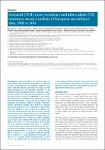Isoniazid (INH) mono-resistance and tuberculosis (TB) treatment success: analysis of European surveillance data, 2002 to 2014
Karo, Basel
Kohlenberg, Anke
Hollo, Vahur
Duarte, Raquel
Fiebig, Lena
Jackson, Sarah
Kearns, Cathriona
Ködmön, Csaba
Korzeniewska-Kosela, Maria
Papaventsis, Dimitrios
Solovic, Ivan
van Soolingen, Dick
van der Werf, Marieke J.
Introduction: Isoniazid (INH) is an essential drug for tuberculosis (TB) treatment. Resistance to INH may increase the likelihood of negative treatment outcome.
Aim: We aimed to determine the impact of INH mono-resistance on TB treatment outcome in the European Union/European Economic Area and to identify risk factors for unsuccessful outcome in cases with INH mono-resistant TB.
Methods: In this observational study, we retrospectively analysed TB cases that were diagnosed in 2002–14 and included in the European Surveillance System (TESSy). Multilevel logistic regression models were applied to identify risk factors and correct for clustering of cases within countries.
Results: A total of 187,370 susceptible and 7,578 INH mono-resistant TB cases from 24 countries were included in the outcome analysis. Treatment was successful in 74.0% of INH mono-resistant and 77.4% of susceptible TB cases. In the final model, treatment success was lower among INH mono-resistant cases (Odds ratio (OR): 0.7; 95% confidence interval (CI): 0.6–0.9; adjusted absolute difference in treatment success: 5.3%). Among INH mono-resistant TB cases, unsuccessful treatment outcome was associated with age above median (OR: 1.3; 95% CI: 1.2–1.5), male sex (OR: 1.3; 95% CI: 1.1–1.4), positive smear microscopy (OR: 1.3; 95% CI: 1.1–1.4), positive HIV status (OR: 3.3; 95% CI: 1.6–6.5) and a prior TB history (OR: 1.8; 95% CI: 1.5–2.2).
Conclusions: This study provides evidence for an association between INH mono-resistance and a lower likelihood of TB treatment success. Increased attention should be paid to timely detection and management of INH mono-resistant TB.
Dateien zu dieser Publikation

